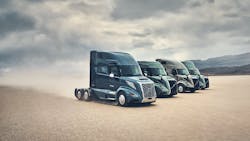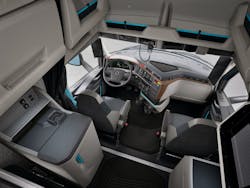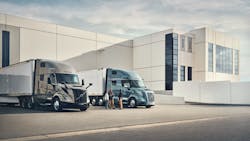Volvo Trucks North America is reimagining the Class 8 truck with a re-engineered Volvo VNL tractor developed by its U.S. team over the past six years. OEM leaders said it will be the base platform for current and future transportation technologies—from diesel to renewable fuels.
The newly designed VNL, available in six cab configurations, was designed for fuel efficiency, safety, driver productivity, connected services, and uptime. VTNA leaders said it would open order books by April for the new VNL, which will be produced at the Volvo Trucks New River Valley Plant in Dublin, Virginia, with first deliveries during the second half of 2024.
"This is our most innovative, fuel-efficient, and safest truck ever," Peter Voorhoeve, VTNA president, said during the OEM's virtual unveiling of the vehicle during a YouTube live stream on Jan. 23. "From our aerodynamics and performance improvements, best-in-class driver environment to our new industry-leading proprietary active safety systems, with the new Volvo VNL we are introducing the platform for all our future technologies such as battery electric fuel cell and autonomous trucks. Products that address and meet our sustainability goals to transition towards a decarbonized transport solution."
See also: The future is almost here for latest truck technology
New Volvo VNL features
The new Volvo VNL, designed for long-haul trucking, will be packaged into four exterior and interior trim levels—Core, Edge, Edge Black, and Ultimate—with six cab configurations, including a day cab option:
- VNL 300 Day Cab
- VNL 440 42-inch Mid-Roof Sleeper
- VNL 640 62-inch Mid-Roof Sleeper
- VNL 660 62-inch Full-Height Sleeper
- VNL 840 74-inch Mid-Roof Sleeper
- VNL 860 74-inch Full-Height Sleeper
Engine and transmission options
The latest generation D13 engine powers the new Volvo VNL in four horsepower ratings, ranging from 405 to 500hp, and three torque ratings from 1,750 to 1,950 lb-ft of torque.
These different power options aim to suit different applications and incorporate an optimized I-Shift transmission featuring up to 30% faster shift speeds.
VNL sets up Volvo Trucks' journey to zero
The new VNL is a significant step for Volvo Trucks' global journey toward zero emissions and zero accidents, Voorhoeve said.
Voorhoeve said the Volvo VNL will be the platform for emerging transportation technologies, including battery-electric, fuel cell, and internal combustion engines running on renewable fuels, including hydrogen. The VNL also features what Volvo Trucks said is the first 24-volt electrical infrastructure in North American trucking that supports VTNA's active safety features and will be standard for future autonomous trucks.
The 24-volt architecture will help minimize battery and electrical failures and improve serviceability when pinpointing and repairing electrical issues. A new linear exhaust aftertreatment system will be easier to service and deliver better DEF treatment for an even cleaner system.
Voorhoeve said the new truck was basically redesigned and built from scratch. "We've listened to our customers here in North America, and we've looked at the requirements here in North America for the next coming decades, and we put all that into the truck behind us," he said while sitting in front of a VNL model during a media during a Q&A session following the public launch.
"This truck is designed to change everything," the VTNA leader said. "It will set new standards in the transport industry, new standards for fuel efficiency, new standards for safety, new standards for driver productivity, new standards for uptime, and connectivity."
See also: Sneak Peek: World of Volvo celebrates brand's history and future
'Most connected truck ever'
Nicole Portello, VTNA's chief digital officer, called the new VNL the company's "most connected truck ever," building on the extensive Volvo Connect telematics platform launched last fall to put all of Volvo Trucks' digital service in one platform for better fleet management. All new Volvo trucks come with a 24-month Volvo Connect subscription.
For the driver
The new VNL offers various active safety systems, including Volvo Active Driver Assist Plus with Pilot Assist, which provides active lane centering. Volvo Dynamic Steering powers Volvo Active Driver Assist Plus to improve maneuvering at all speeds, including more controlled backing and increased stability on the road. It adapts and corrects for crosswinds, highway crowning, soft shoulders, or emergencies such as tire failure.
Volvo offers a new, optional air suspension system, GRAS (Global Rear Air Suspension), that uses dual leveling rods to reduce roll and pitch angles, improve lateral stability, and minimize road shocks, maintaining a constant ride height.
GRAS and the supporting Volvo Smart Suspension software work with the Volvo Dynamic Steering system to provide precise steering control and reduce driver fatigue regardless of load, terrain, road conditions, and varying engine torque levels. GRAS with Volvo Smart Suspension gives drivers three different settings to adjust the suspension for various loading and unloading conditions.
For more efficient idling, the long-haul tractor features a new ultra-quiet, proprietary, integrated Volvo Parking Cooler, a climate-control option that utilizes the onboard 24-volt battery system to power the cab’s HVAC when parked, reducing emissions, engine wear, and fuel costs. VTNA also says it eliminates noise and vibration from idling.
In-cab amenities include an optional folding bunk to allow access to the dinette space, a singular multi-functional control panel in the back of the cab, upgraded climate control and noise reduction insulation, a larger refrigerator, and enough power options to support various devices.
Safety offerings
The new pedestrian detection feature alerts the driver when a pedestrian or bicyclist may be in their path or blind spots and will activate frontal automatic emergency braking for objects directly in the path of travel.
Passive safety systems in the new Volvo VNL include the bonded and wrapped windshield to offer drivers panoramic views of their surroundings while improving aerodynamics and reducing wind noise in the cab.
The VNL cab, constructed of high-strength steel, is designed according to Volvo Trucks’ leading crash test standards and will offer a side-curtain airbag, with options for driver-only or driver and passenger airbags, a North American industry first.
Volvo Trucks’ flared frame rails allow the powertrain to drop below the cab to protect the driver.
E-Call, an innovative new safety feature, connects the driver to emergency services and provides precise location details. This occurs automatically if the vehicle is in a rollover crash or airbags are deployed.
Now drivers can also stay connected to their VNL with the Volvo MyTruck app. It lets drivers monitor their truck's fuel, DEF, and coolant levels and receive notifications about potential problems. They can also remotely set the cab's climate control to reach their preferred temperature before they climb inside for work. It also features a trucking-centric navigation system and more safety features inside and outside the cab.
If the truck is involved in a rollover or other accident that causes its airbags to deploy, the E-Call system connects the driver to emergency services and provides precise location details.
See also: 2024 new truck models
'SuperTruck' and regulatory influences
The new VNL's striking aerodynamic design can achieve up to 10% improvement in fuel efficiency from previous models. The new model's streamlined and more angular, wedge-shaped cab features a dramatically redesigned windshield, helping it achieve those fuel savings.
Engineers created more aerodynamic gains by integrating the curved and bonded windshield, tighter clearances around turbulent air areas such as the wheel openings, bumper and hood, chassis fairings, and making a tighter trailer gap.
These designs, all critical components of the aerodynamic gains, were developed and tested in parallel with Volvo Trucks' SuperTruck 2, according to Johan Agebrand, Volvo Trucks' product marketing director.
The stricter emissions regulations facing the industry later this decade are on VNL engineers' minds, but Agebrand said they were the "minimum bar of what needs to be in there. That's not good enough for us at Volvo. We go far beyond that. So the majority of stuff in there is about what kind of truck we want to provide for the next seven, 10 years. Is it regulations? Yeah, we need to comply. But that has not been the benchmark to go by—we far surpass that."
Federal clean truck rules finalized last year are pushing OEMs to create more environmentally friendly heavy-duty equipment by 2027. The emission reductions pushed by the Environmental Protection Agency will increase as more new, cleaner vehicles enter the market.
Voorhoeve said the new VNL platform was designed "to be compliant with all the regulations now and in the future. I think that the purchasing of your fleet is steered by your replacement cycle. It is steered by your freight demand," he said of fleet customers. "I think if you go with the new VNL, you have a very safe choice to drive your bottom line in a better way for a fleet owner or an owner-operator. We've designed this truck to drive value. It's about fuel efficiency. This is about driver retention. This is about safety. I think all of those considerations are important with purchases before and after 2027."
Fleet customers can choose optimal powertrain packages based on their application duty cycle and fuel efficiency goals by selecting from three powertrain packages featuring the Volvo D13 engine with five different horsepower and torque ratings available.
Customers can also select from several safety packages so their trucks have the technology to meet fleet safety goals.
Volvo Trucks spent $400 million to upgrade its cab plant for the all-new Volvo VNL next to its New River Valley Plant in Dublin, Virginia. Since 1982, VTNA has built all its North American trucks in the U.S. "We're very proud of that. This is a truck designed in America, developed in America, and built in America," Voorhoeve said.
About the Author
Josh Fisher
Editor-in-Chief
Editor-in-Chief Josh Fisher has been with FleetOwner since 2017. He covers everything from modern fleet management to operational efficiency, artificial intelligence, autonomous trucking, alternative fuels and powertrains, regulations, and emerging transportation technology. Based in Maryland, he writes the Lane Shift Ahead column about the changing North American transportation landscape.




